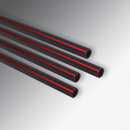March 5, 2013 PEX Tubing
What Is PEX Tubing?
PEX is the short term for Cross-linked (hence, “X”) PolyEthylene (PE) and is created during the extrusion process by forming links between molecules. The cross-linking process improves the chemical and temperature performance ratings of the polymer, gives it flexibility and extra strength.
Like a chain-link fence, PEX will expand with excessive pressure and then return to its original shape when the pressure is removed – so PEX pipe will usually allow the expansion of water that freezes inside. Non-crosslinked pipe is rigid. It may resist higher pressure before initial expansion, but once it does deform and expand, it is forever changed and weakened.
Types of PEX
All PEX is generally divided into 3 main types: A, B and C, the most common types being PEX-A and PEX-B. It is a misconception to think that one type is better than the other simply because it’s an A, B, or C type. These letters are used to identify the manufacturing process and have nothing to do with quality of performance ratings.
All types of PEX have to comply with ASTM F876 and ASTM F877 standards before they can be used anywhere in the US. Pipe that conforms to these standards carries a proper readable imprint.
How is PEX Tubing Made?
PEX-A tubing is produced using Peroxide (or, “Engel”) method, named after the inventor Tomas Engel. During the manufacturing process, free radicals are created when HDPE polymer is melted and cross-links between molecules occur at temperatures that exceed the decomposition temperature of the polymer.
PEX-B is made using a “Silane” or “Moisture Cure” method of cross-linking, where links between the molecules of the HDPE form after the extrusion process using a catalyst and exposing PEX tubing to water. This type of PEX is the most common and is manufactured by a large number of companies, including Viega.
PEX-C is manufactured using “Electronic Irradiation” method of cross-linking, also known as “Cold” cross-linking. Here, cross-linking of the molecules is done after the process of extrusion by exposing the pipe to an electron radiation beam. The radiation emitted allows to break the existing links between molecules of the polymer and initiate cross-linking process.
The Best Uses For PEX Tubing
There are multiple uses of PEX tubing, including:
- Radiant Heat
- Snowmelt
- Plumbing
- Cooling
- Fire Protection
Manufacturers of PEX Tubing
TJ’s has been fortunate to be able to witness, first-hand, the manufacturing process of PEX-C tubing, in Germany. Below are several manufacturers that we work with and their fact sheets on their particular type of PEX tubing.
Rehau
Uponor
Viega
Thoughts On PEX Tubing From the President of TJ’s
Our biggest concern when using PEX tubing is to make sure we are using the right PEX for the right application. TJ’s most common uses of PEX is in plumbing applications, radiant heating and snowmelt.
When using PEX tubing for water piping and other plumbing applications, there does not need to be an oxygen barrier. When water is introduced, it brings in oxygen at the same time. However, we do ensure that any PEX tubing we use for plumbing purposes is cross-linked.
For heating applications, including radiant heat and snowmelting, TJ’s prefers PEX tubing with an oxygen barrier, that is flexible, so either PEX-A or PEX-B tubing. When running to manifolds, piping baseboard, radiators, etc, we prefer PEX-AL-PEX or FostaPEX tubing. This type of tubing is made of a layer of aluminum sandwiched between two layers of PEX. The metal layer serves as an oxygen barrier, stopping the oxygen diffusion through the polymer matrix, so it cannot dissolve into the water in the tube and corrode the metal components of the heating system. The aluminum layer is thin, typically 1 or 2 mm, and provides some rigidity to the tube such that when bent it retains the shape formed (normal PEX tube will spring back to straight). The aluminum layer also provides additional structural rigidity such that the tube will be suitable for higher safe operating temperatures and pressures, thereby acting similar to copper tubing.
All PEX systems, with the exception of PEX-AL-PEX and FostaPEX, have very high expansion rates of 1.1 inches of expansion for every 10 degree rise in temperature. It is our recommendation to follow each manufacturer’s specifications to ensure that this expansion rate is taken into account during installation.
Contact TJ’s For More Information
TJ’s has the expertise and experience to ensure a professional, long-lasting installation of your plumbing, heating, and cooling systems.
CONTACT US TODAY to discuss your installation.
Blog Archives
- February 2023
- January 2023
- October 2021
- September 2021
- February 2021
- August 2020
- July 2020
- April 2020
- March 2020
- February 2020
- October 2019
- March 2018
- February 2018
- November 2017
- August 2017
- April 2017
- March 2017
- February 2017
- January 2017
- September 2016
- January 2016
- June 2015
- April 2015
- March 2015
- February 2015
- January 2015
- August 2014
- May 2014
- April 2014
- March 2014
- February 2014
- November 2013
- August 2013
- July 2013
- June 2013
- May 2013
- April 2013
- March 2013
- February 2013
- January 2013
- December 2012
- October 2012
- August 2012
- June 2012
- May 2012
- April 2012
- March 2012
- February 2012
- January 2012
- December 2011
- November 2011
- October 2011
- September 2011
- August 2011
- July 2011
- June 2011
- April 2011
- February 2011
- January 2011



